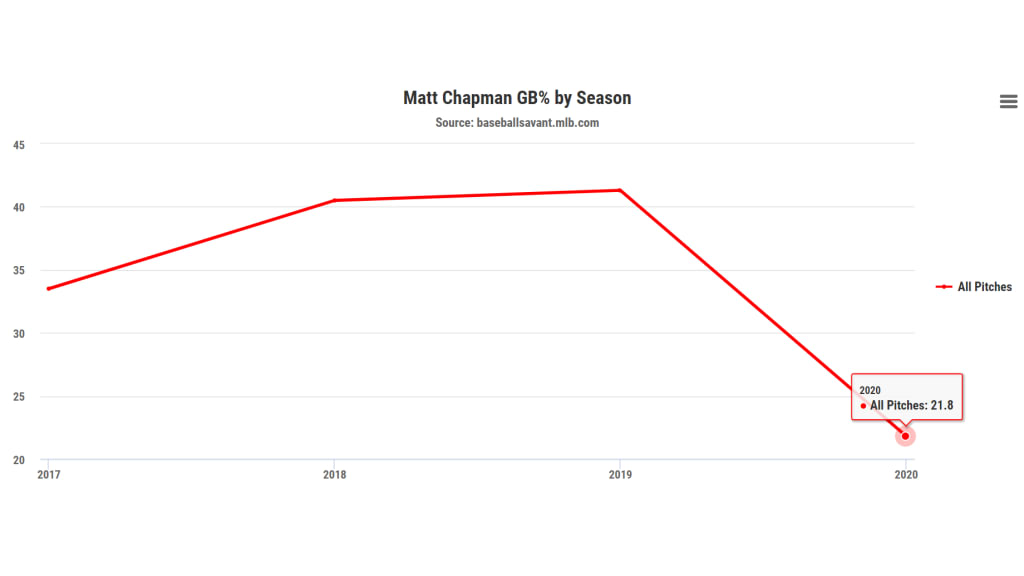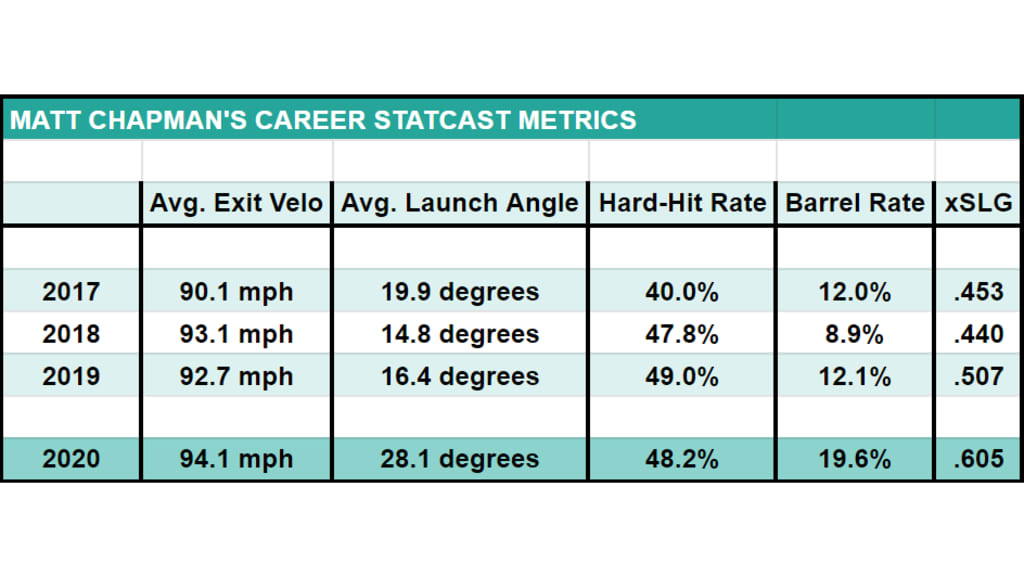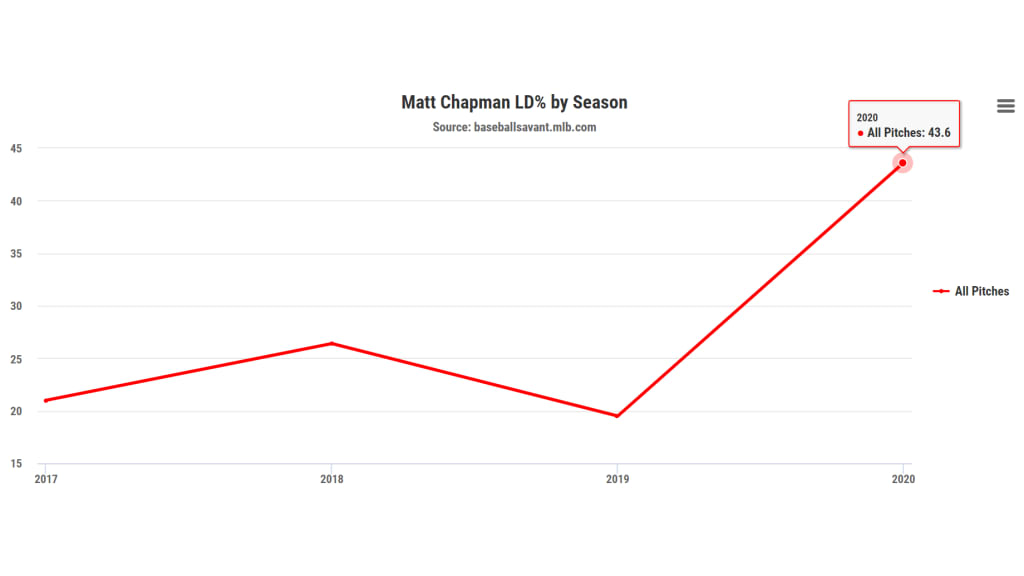Matt Chapman has taken away way too many hits on the left side of the infield to ever want to put the ball on the ground himself. So he's just stopped doing it.
The A's star third baseman is the most extreme air-ball hitter in the Major Leagues this season. And overall that's a good thing.
Highest rate of air contact, 2020
Min. 40 batted balls (151 hitters)
Matt Chapman (OAK): 78.6%
Trevor Story (COL): 75.4%
José Ramírez (CLE): 74.2%
Nolan Arenado (COL): 73.5%
Max Kepler (MIN): 71.7%
Anthony Santander (BAL): 71.6%
Whit Merrifield (KC): 71.4%
Mike Trout (LAA): 70.8%
Charlie Blackmon (COL): 70.1%
It's not like Chapman needs to make a leap to be an MVP candidate. He already made that leap over the last two seasons, with his power hitting growing to supplement his elite glove. But his air attack could push his hitting to where "MVP vote-getter" becomes "MVP finalist."
Chapman is second in the American League with 48 total bases, thanks to a Major League-high 13 extra-base hits -- six homers, five doubles and two triples. That slug doesn't come on the ground.
Let's break down what Chapman is doing right.
He's cut his ground-ball rate more than any hitter

Chapman's 41.7% ground-ball rate last season wasn't high by any means; you don't hit 36 home runs in a season by going ground-ball heavy. But he's still cut it nearly in half this season. No regular hitter has slashed his ground-ball rate more than Chapman.
Largest GB rate decreasers, 2019 to 2020
Min. 100 batted balls in '19 and 40 batted balls in '20
Matt Chapman (OAK): -20.3 points (41.7% to 21.4%)
José Iglesias (BAL): -13.8 points (53.3% to 39.5%)
Anthony Santander (BAL): -11.9 points (40.3% to 28.4%)
Starlin Castro (WSH): -11.9 points (48.1% to 36.2%)
Charlie Blackmon (COL): -10.4 points (40.3% to 29.9%)
Nolan Arenado (COL): -10.3 points (36.8% to 26.5%)
Jesús Aguilar (MIA): -10.3 points (42.9% to 32.6%)
The air contact leaders and largest ground-ball decreasers are a mix of stars and strong starters in 2020 -- Blackmon hitting close to .500, Santander ranking an out-of-nowhere second in the AL in RBIs to Aaron Judge, Trout is Trout, and so on. But Chapman tops the lists, and he plays Platinum Glove defense, too.
Just getting the ball off the ground isn't all there is to it, of course. Hitting the ball in the air is Step 2. We have to rewind to Step 1.
He's lifting his best contact
Step 1 is hit the ball hard. Chapman has always hit the ball really hard, a lot, and he's still hitting the ball really hard, a lot. And he's taking all that hard contact into the air.
Here's a look at Chapman's Statcast data.

Chapman has always had the elite exit velocity -- he's been in the top 10 in MLB each of the past three seasons -- and he's at a career best. A hard-hit ball is 95-plus mph; Chapman is averaging close to that. Almost half his batted balls are hard-hit. That's great.
But what you really want to pay attention to is the launch. About one in every five balls Chapman has hit this season is a "barrel" -- the best level of contact, requiring ideal exit velocity and ideal launch angle. Barrels are the kind of contact that turns into home runs and extra-base hits. Chapman is tied for the Major League lead with 11.
Most barrels, 2020
Matt Chapman (OAK): 11
Corey Seager (LAD): 11
Jorge Soler (KC): 11
Nick Castellanos (CIN): 11
Fernando Tatis Jr. (SD): 10
Brandon Lowe (TB): 10
Going back to the 151 hitters with 40 or more batted balls this season, Soler, Castellanos and Seager are the only ones barreling the ball at a higher rate than Chapman. One in every eight plate appearances has ended with Chapman barreling the ball, behind only Seager, Soler, Eloy Jiménez, Bo Bichette and Castellanos.
Of Chapman's 27 hard-hit balls in 2020, only four are ground balls. That's just 14.8% of his hard contact. In 2019, 37.6% of Chapman's hard-hit balls went on the ground. That's not a waste, exactly -- hitting the ball hard is always good -- but what he's doing now is better.
He's in the sweet spot a lot
The one cost of Chapman's extreme air attack is popups -- he's running a very high popup rate, over 20%. That's not good. Popups are automatic outs; at least ground balls are sometimes hits. But the price has been worth paying ... for now, at least ... for all the strong air contact Chapman is making.
He'll want to bring some of those popups down and turn them into dangerous fly balls. But on the whole, Chapman is hitting a lot fewer balls on the two bad ends of launch angle, grounders and popups, than he is in the good middle portion, line drives and fly balls. If a fifth of his batted balls are grounders, and a fifth are popups, that puts three of five balls he hits in the productive air-ball range where a hitter wants to be.
Far more of Chapman's contact is in the launch angle "sweet spot." Statcast defines the sweet spot as 8-32 degrees, because that covers both the best range for home runs (24-32 degrees) and the best range for base hits (8-16 degrees).
Chapman is keeping almost half of his total batted balls in that sweet-spot zone -- 46.2%, the fourth-highest sweet-spot rate among MLB regulars behind Iglesias, Bichette and Wil Myers. His previous high was 31.5% as a rookie. And no one has more hard-hit balls in the launch angle sweet spot than Chapman this season.
Most hard-hit balls in launch angle sweet spot, 2020
Matt Chapman (OAK): 19
Mookie Betts (LAD): 19
Corey Seager (LAD): 17
Salvador Perez (KC): 17
Freddie Freeman (ATL): 16
Those 19 batted balls make up over a third of Chapman's total contact, the second-highest combined hard-hit/sweet-spot rate of the 151-hitter group from before, behind only Ronald Acuña Jr. It's also double the hard-hit/sweet-spot rate Chapman posted in any other season of his career.

Chapman's doing most of his damage via the line drive -- while he has a combined line drive/fly ball rate approaching 60%, he's hitting three line drives for every fly ball. Fly balls are better for home runs specifically; line drives are better for the hitter's fundamental goal of not getting out. Let's be clear: both are good.
If you hit the ball hard like Chapman does, you want to elevate it. That's where the damage lies, and Chapman has found the range. If he keeps driving the ball in the air like this, you could be looking at the league's strongest offensive/defensive two-way force.
